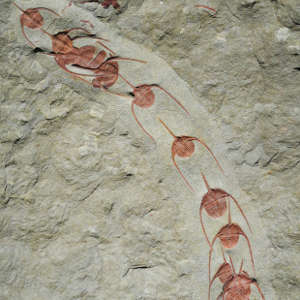Using AI to control energy for indoor agriculture
30 September 2024
Published online 21 October 2019
Extinct marine arthropods provide evidence of ancient collective behaviour.

Jean Vannier, Laboratoire de Géologie de Lyon: Terre, Planètes, Environnement (CNRS / ENS de Lyon / Université Claude Bernard Lyon 1)
The fossils show the 20mm-long Ampyx priscus arthropods facing in the same direction while forming an orderly queue. This indicates that they probably moved in groups, according to researchers from France, Morocco and Switzerland, who discovered the fossils. The Ampyx had no eyes, and appear to maintain contact with one another via stout, long spines at the front of their bodies. The researchers hypothesize they may have coordinated their movements using sensory stimulation by means of their spines or chemicals.
It is possible that the group motion was instigated as a stress response to turbulent storm-stirred waters, motivating Ampyx to migrate to calmer waters, or that it was a seasonal migration of sexually mature individuals to spawning grounds.
This is a snapshot of collective behaviour that “dates back to the first biodiversification events of animal life in ancient seas,” says palaeontologist, Jean Vannier, from the University of Lyon, in France.
The behaviour, also seen in modern spiny lobsters, ants and caterpillars, emerged to respond to environmental stresses and predator attacks, he says.
The team believes it is likely the ancient arthropods were suddenly buried while travelling by storm-stirred sediments.
doi:10.1038/nmiddleeast.2019.141
Vannier, J. et al. Collective behaviour in 480-million-year-old trilobite arthropods from Morocco. Sci. Rep. 9,14941 (2019).
Stay connected: